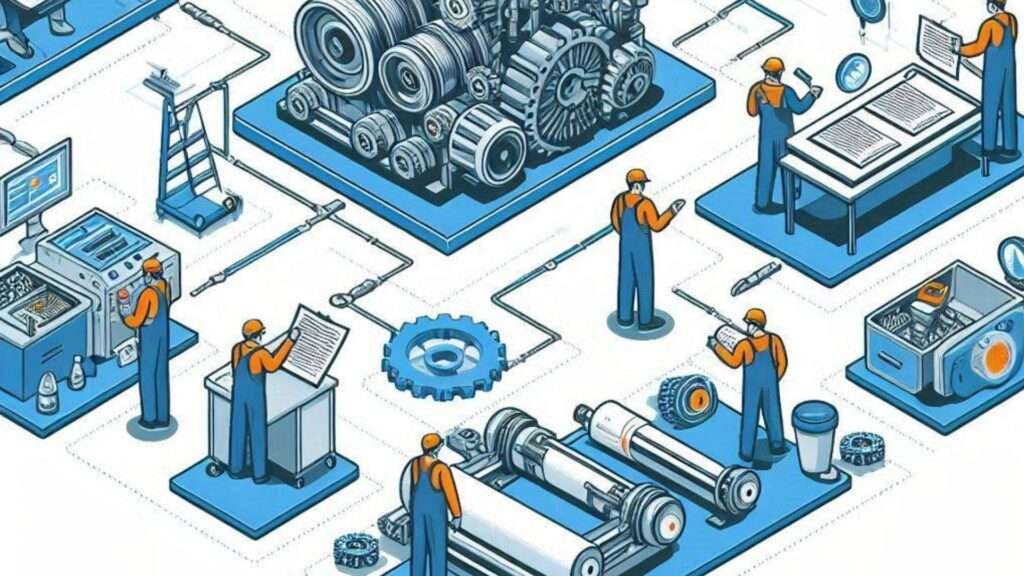The Dream Of Designing The Ultimate Asset Management Software Product.
Asset management software is one of the most
significant investments that an asset-intensive business will make.
The ever-increasing complexity and scope of
development required to provide us with high-quality Asset Management Software
(AMS) products is nothing short of mind-blowing.
Make no mistake, developing effective asset
management software is a significant challenge for developers.
Our company AMS must optimise asset utilisation, manage
budgets, analyse a plethora of key performance indicators and ensure regulatory
compliance all while providing a user-friendly interface.
The development process requires balancing
various, often conflicting, requirements. The software must be fast and
reliable, capable of handling large data volumes without compromising security
or responsiveness.
The GUI/user interface must be enjoyable to use, make
plenty of sense to users with varying levels of technical expertise and be ergonomically
designed to cater for long periods of use.
Achieving this balance of high performance, perfect
adaptability and complete ease of use is crucial for creating an effective
asset management solution that will be competitive in the market, get you lots
of great Google reviews and keep the doors open for as long as possible.
Developing comprehensive asset management software
demands meticulous design, innovative architecture, and a deep understanding of
user needs, making it a formidable challenge for even the most seasoned developers.
Table Of Contents:
1.0
Introduction: The Impossible Software Dream.
2.0 The
Multifaceted Demands of Modern Businesses.
3.0 Key
Challenges in Developing Asset Management Software.
4.0
Walking The Technology Tightrope.
5.0 The
Very Complex Price Paradox.
6.0
Strategies for Software Development Success.
7.0
Maintaining Simplicity and Ease-of-Use.
8.0
Conclusion.
1.0
Introduction: The Impossible Software Dream.
Asset management software represents a significant
investment for organizations, but its value extends far beyond its primary
function.
These powerful software products are indispensable
for businesses striving to remain effective, efficient, compliant and
competitive.
Its reach spans across nearly every facet of
company operations, making it a cornerstone of modern business infrastructure.
For developers of asset management software, the
challenge lies in creating a product that simultaneously achieves multiple
objectives.
In the backend, it must optimise asset
utilization, reduce operational costs, and ensure strict regulatory compliance
whilst simultaneous in the front end, provide an intuitive and user-friendly
interface that simplifies complex processes for end-users and offers something
that people actually like using.
The task of designing asset management software
that satisfies such diverse requirements could be likened to engineering the
worlds fastest supercar that can effortlessly transition to off-road adventures
on the weekend, tow a caravan with ease and put a boat in and out of water, all
while remaining within the budget of an average joe.
This analogy probably only just starts to capture
the monumental challenges developers face in creating a versatile,
high-functioning and highly sougtht after asset management solution that caters
to a wide array of business needs without breaking the bank.
The complexities of such an endeavour arise from
the need to balance various, often conflicting, requirements.
Performance and speed must be matched with
reliability and robustness, ensuring the software can handle vast amounts of
data without compromising on security or responsiveness.
Then there’s the matter of ensuring versatility in
functionality, which should include asset registers/hierarchies, maintenance
work initiation, planning, scheduling, and execution, maintenance performance
analysis, compliance management, and a thousand other tasks.
All of the above, and more, must be unified in a
coherent, accessible interface that is comparable to SAP but ten times less
expensive, and it must be intuitive enough for users of varying technical
proficiency without requiring extensive training or support.
To be honest, I’m not sure how developers can
remain rational.
Just as the dream of a supercar capable of
excelling in diverse environments appears almost utopian, the creation of an
all-encompassing asset management software demands meticulous design,
innovative architecture, and a profound understanding of user requirements.
This combination of high performance,
adaptability, and user-friendliness forms the crux of an effective asset
management solution, guiding organizations in their pursuit of efficiency and
profitability.
2.0
The Multifaceted Demands of Modern Businesses.
Aset intensive businesses require quality asset
management software capable of handling a broad spectrum of needs.
Industries manage a variety of asset types, in
varying production environments and with all manner of variants to contend with.
Each asset category presents its own set of
complexities and management requirements, hence the need for robust and
versatile software solutions.
The regulatory environment adds another layer of
complexity to asset management. Organizations must comply with numerous local, state/territory,
federal and sometimes international, it all depends on what you are doing, how
you are doing it and where your operation is located.
This not only demands flexible compliance features
within the software but also the ability to support audit trails, reporting
tools, and frequent updates to adhere to evolving legal standards. Failure to
comply can result in significant fines, legal constraints, loss of your licence
to operate and reputational damage.
Another critical requirement for modern businesses
is multi-currency and global operations support.
As companies expand their reach across borders,
asset management software must be equipped to handle transactions and
valuations in multiple currencies, varying tax regimes, and international
financial regulations.
The ability to operate seamlessly on a global
scale is no longer a luxury but a necessity for maintaining competitive
advantage and operational efficiency.
Interfacing or Integration with existing systems
is crucial to streamline operations and increase productivity. For more on this particular subject you can
refer to: Interface
Disparate Systems Data With A CMMS.
Asset management software should be able to seamlessly
connect with other business management systems, operations management software
such as Citec or DCS, customer relationship management (CRM) platforms, and
other critical business applications such as predictive maintenance software or
tyre management software (with mining, transport etc).
Smooth integration ensures real-time data
synchronization, reduces the likelihood of errors, and eliminates redundant
processes.
This holistic approach to asset management can
significantly enhance an organization’s operational workflow and
decision-making capabilities.
Taken together, these diverse demands underscore
the importance of designing asset management software that is not only powerful
but also adaptable to the unique requirements of modern business environments.
By addressing these multifaceted needs,
enterprises can optimise asset utilization, maintain compliance, and improve
overall efficiency in a complex, interconnected world.
3.0
Key Challenges in Developing Asset Management Software.
When it comes to developing impressive asset
management software, several key challenges must be addressed to create a
system that effectively balances performance, versatility, and usability.
One of the principal hurdles is achieving a
harmonious blend of functionality and user-friendliness.
In an increasingly fussy and ridiculously demanding
world, users demand robust functionalities while expecting intuitive,
easy-to-navigate interfaces.
Overloading the software with features can render
it too complex, deterring user adoption, while excessively simplifying it can
restrict its utility.
Scalability is another significant challenge.
Asset management software must cater to a diverse range of business sizes, from
small start-ups to large multinational corporations.
Designing a system that scales horizontally and
vertically to accommodate varying data volumes and user counts without
compromising performance demands foresight and meticulous planning.
Ensuring the software remains responsive and
functional under increased loads is paramount to its success.
The balance between customisation and
standardization also poses a considerable challenge.
There is also the need for users to be able to
personalise the front end to best suit them as well, you notice this when you
walk through a large maintenance office where they are all using SAP, you’ll
notice just about everyone has personalised their GUI differently, whether it’s
the colour choices, layout or dark mode etc, it is rare to see more than 2 the
same in an office
While bespoke solutions offer businesses the
ability to tailor the software to their specific needs, they often come with
higher costs and longer development times.
Conversely, standardized solutions can expedite
deployment and reduce costs, but they may not align perfectly with an
organization’s unique requirements.
Striking an appropriate balance between these two
aspects is crucial to meeting client expectations.
Data security and privacy concerns further
complicate the development process. Asset management systems often store highly
sensitive information, necessitating stringent security measures.
Developers must implement robust encryption,
authentication, and authorization mechanisms to safeguard data integrity and
confidentiality. Compliance with data protection regulations, such as GDPR and
CCPA, adds an additional layer of complexity.
Finally, managing development costs is an
omnipresent challenge. Developing comprehensive, high-quality asset management
software commands substantial resources.
Budgetary constraints often necessitate prioritising
feature development and resource allocation without compromising overall
quality.
Balancing cost-effectiveness with the need to
deliver a reliable and functional solution is a delicate but essential task.
Addressing these challenges requires a nuanced
approach that considers the specific needs and constraints of end-users, while
maintaining a focus on delivering a good performing, versatile, and
user-friendly asset management system.
4.0
Walking The Technology Tightrope.
Designing something new and impressive in the asset
management software space is a complex and stressful endeavour, primarily due
to the rapid pace of technological evolution.
Keeping up with new advancements and seamlessly
integrating them into the existing framework is paramount.
The debate between cloud-based and on-premises
solutions is a key consideration. Cloud-based solutions offer the advantage of
accessibility from any location, reduced infrastructure costs, and automatic
updates.
However, on-premises solutions provide enhanced
control, customisation, and potentially heightened security, which is crucial
for organizations with stringent data governance policies.
Mobile accessibility is another essential factor.
As the modern workplace becomes increasingly mobile, ensuring that asset
management software is responsive across various devices is imperative.
Responsive design enhances usability, ensures
widespread accessibility, and significantly improves user experience.
This need for mobility extends beyond mere
accessibility; it demands a fluid, intuitive interface that translates
seamlessly from desktop to mobile environments.
AI Integration in Asset Management Software.
The integration of artificial intelligence (AI)
and machine learning into asset management software presents significant
potential benefits, revolutionizing how businesses manage and maintain their
assets.
As AI continues to evolve rapidly, two pivotal
approaches are emerging:
1.
Predictive AI
2.
Generative AI.
Both will no doubt reshaping industries and
technological landscapes, including asset management.
The Promise of AI in Asset Management.
AI can transform asset management software by:
1.
Automating routine tasks.
2.
Providing predictive analytics
for better decision-making.
3.
Identifying patterns that might
go unnoticed through manual analysis.
4.
Learning from historical data,
continuously improving accuracy and efficiency.
5.
Transforming raw data into
actionable insights, fostering a more proactive approach.
Predictive AI in Asset Management.
Predictive AI is able to focus on analysing vast
amounts of historical asset management data to forecast future outcomes with
impressive accuracy.
In the context of asset management software,
predictive AI can:
·
Forecast future maintenance
requirements.
·
Predict potential equipment
failures before they occur.
·
Optimise inventory levels based
on predicted demand.
·
Suggest optimal maintenance
schedules to minimize downtime. This
particular area is where I think things could get very exciting, imagine an AI
that will be simultaneously analysing mining department data, processing plant
data, all asset data, maintenance data, weather data etc, it could work out the
perfect time to plant maintenance shutdowns.
This approach has found applications across
numerous sectors, including manufacturing, energy, and infrastructure
management.
Generative AI in Asset Management.
In contrast, generative AI in an asset management
software environment would potentially create new, original content based on
patterns learned from core asset data.
This revolutionary approach could lead to
breakthroughs in maintenance and engineering approaches we have yet to
consider, such as:
1.
Generating detailed maintenance
procedures tailored to specific asset conditions
2.
Creating innovative asset
configuration recommendations. It could
work out that you are not operating an item of plant in the optimum way.
3.
Developing new preventive
maintenance strategies based on complex data patterns. It could suggest you take your plant offline
to do work on a particular machine that you have never previously thought of.
4.
Producing comprehensive reports
and visualizations of asset performance and trends
Generative AI is thanks to NVIDIA and it got
kicked of in the gaming arena.
Synergy of Predictive and Generative AI.
While distinct in their primary functions,
predictive and generative AI often complement each other in advanced
applications:
·
A predictive model might forecast
maintenance trends, while a generative model could create a detailed maintenance
request based on those predictions.
·
Predictive AI could anticipate
maintenance department behaviour, while generative AI could create dynamic,
responsive maintenance tasks.
This synergy has the potential to create a more
intelligent, adaptive asset management system that not only reacts to current
conditions but also proactively shapes future strategies.
The Role of High-Performance Computing.
Companies like NVIDIA, a leader in
high-performance computing, play a crucial role in supporting and advancing
both these AI paradigms through cutting-edge hardware and software solutions.
Their technologies enable the processing power
needed to run complex AI models in real-time, making it possible to implement
these advanced AI capabilities in asset management software.
Looking Ahead.
As we look to the future, it will be worth keeping
a close eye on developments in both predictive and generative AI over the next
12 months.
The potential applications in asset management are
vast, and we’re likely to see continued innovation in this space.
While it’s challenging to predict the full extent
of AI’s impact, it’s clear that these technologies have the potential to
significantly enhance the efficiency, accuracy, and proactive nature of asset
management processes.
As AI continues to evolve, we can expect to see
even more sophisticated applications that may fundamentally transform how we
approach asset management.
In any event, as exciting as AI is now and will
get, one challenge in this technological landscape is balancing these
innovations while maintaining performance and keeping a lid on the price of
your product.
Software must handle large datasets without
compromising speed or reliability. Therefore, using optimised algorithms and
efficient database management techniques is critical.
Furthermore, ensuring robust security measures to
protect sensitive data from increasingly sophisticated cyber threats is
non-negotiable. It’s probably worth checking out: Cyber
Security For CMMS Development Companies – CMMS Success
Navigating the technological landscape in asset
management involves a careful balance.
By leveraging advancements in cloud computing,
mobile responsiveness, AI, and machine learning, one can develop software that
not only meets current needs but is also well-positioned to adapt to future
demands.
5.0
The Very Complex Price Paradox.
Before delving into the specific challenges of
asset management software pricing in this section of the article, it’s
important to understand the concept of a paradox.
A paradox is a statement, situation, or concept
that seems self-contradictory or absurd but may be true in reality.
Paradoxes often reveal complexities or limitations
in our thinking and can lead to deeper insights when explored.
In the context of software economics and product
development, a price paradox refers to a situation where pricing decisions lead
to unexpected or counterintuitive outcomes.
Developing asset management software presents a
dilemma that exemplifies a price paradox, you’re always balancing development
costs with market expectations.
This paradox often emerges when companies strive
to create robust, versatile, and user-friendly solutions while maintaining
affordability.
The price paradox in asset management software
manifests in a few ways:
·
Higher development costs leading
to higher prices, potentially reducing market adoption.
·
Lower prices potentially signalling
lower quality, despite the actual robustness of the solution.
·
The need to recover substantial
development investments conflicting with competitive pricing pressures.
This paradoxical situation forces companies to
navigate a complex landscape where pricing decisions can have far-reaching and
sometimes counterintuitive effects on market perception, adoption rates, and
long-term profitability.
Developing quality asset management software at a
price that will fly off the shelves (so to speak), has done and probably always
will present a dilemma for the owners of the company.
Balancing development costs with market
expectations is hard, you’re probably aware of what people now want but to make
those major changes is not cheap and probably by the time you’ve made those
changes, had all forms of testing done and are ready to go to market, then the
whole world has changed its mind about what they want and don’t want when it
comes to your type of software.
The price paradox will always be in play as
software companies strive to create robust, versatile, and user-friendly
solutions while maintaining affordability.
The challenge lies in understanding that
development costs can significantly vary based on the complexity and
functionality of the software.
From initial design and coding to rigorous testing
and continual updates, the expenses can quickly add up, making it crucial to
adopt a pricing model that aligns with these financial realities.
One common approach is the subscription-based
pricing model. This framework allows users to pay a recurring fee, ensuring a
steady stream of revenue for continuous improvements and support.
Such a model is particularly advantageous for
asset management software developers, as it aligns their financial interests
with providing ongoing value to users.
Subscribers benefit from regular updates, support
services, and cloud-based solutions, often perceived as more cost-effective in
the long run compared to a significant one-time expenditure.
Alternatively, a one-time purchase model involves
users paying a single upfront fee. While this can be appealing for consumers
looking to avoid recurring expenses, it places a significant burden on
developers to recover their development costs quickly.
Additionally, this model may lead to user
dissatisfaction over time if updates and support are not continually provided,
which could necessitate additional charges, leading to unforeseen expenses for
the user.
Cheap solutions, marketed for their low initial
cost, often fail to meet long-term user expectations. These software variants
might skimp on critical features, lack customer support, or present security
vulnerabilities.
The lower price tag can obscure the true cost of
ownership, which includes the need for frequent troubleshooting, limited
scalability, and potential integration issues with existing systems.
Furthermore, the long-term costs of switching to a more robust solution later
on can significantly exceed the anticipated savings, underscoring the
importance of investing in quality from the outset.
In essence, the price paradox within asset
management software development illustrates the need for strategic pricing
models that reflect the value delivered to users.
Balancing essential development costs with market
expectations is pivotal in fostering user satisfaction and ensuring the
software’s sustainability and success.
6.0
Strategies for Software Development Success.
In designing the ultimate asset management
software, developers have to balance performance, versatility and usability
through well-thought-out strategies.
Firstly, adopting a modular design approach is
imperative. This method involves breaking down the software into smaller,
manageable modules that can be developed, tested, and deployed independently.
Such a structure not only enhances flexibility but
also allows for the easy integration of new features without disrupting core
functionalities.
Focusing on core functionalities is essential in
the initial stages of development. Identifying the primary needs of the
end-users ensures that the fundamental aspects are robust and reliable. This
focus guarantees that the core features are refined, effective, and
user-friendly. Moreover, it establishes a strong foundation for the software,
allowing for seamless scalability and future enhancements.
Engaging in collaborative development with
potential users is another critical strategy. This process involves continuous
feedback loops where users are integral in shaping the software.
Through user-centric design and iterative
feedback, developers can make informed decisions that directly address user
pain points and requirements.
Engaging users early and often helps in creating a
product that truly aligns with their needs and expectations.
Maintaining a cycle of continuous improvement and
updates is vital for the long-term success of asset management software.
Technology and user requirements evolve rapidly,
and so must the software. Regular updates that incorporate performance
enhancements, security patches, and new features help in keeping the software
relevant and efficient. This proactive approach in software maintenance not
only enhances user satisfaction but also extends the software’s lifecycle.
By integrating these strategies, asset management
software can achieve a balanced blend of performance, versatility, and
usability.
Modular design enables flexibility, focusing on
core functionalities ensures robustness, collaborative development promotes
user satisfaction, and continuous improvement guarantees long-term success.
Together, these strategies pave the way for the creation of superior asset
management solutions.
7.0
Maintaining Simplicity and Ease-of-Use.
When engaged with asset management software
design, maintaining simplicity and ease-of-use is paramount.
While the incorporation of advanced features is
vital for functionality, achieving a balance where these complexities do not
hinder user experience is essential. An intuitive interface ensures that users
across varying levels of technical expertise can navigate the software
efficiently, enhancing overall productivity and satisfaction.
To start, prioritising a clean and minimalist
design can significantly contribute to ease-of-use.
This involves focusing on essential elements that
serve the primary functions, avoiding clutter that can overwhelm users.
Opting for a flat design, using icons that are
universally recognized, and employing consistent colour schemes can guide users
intuitively through the software’s features.
Colour Schemes in Asset Management Software user interfaces
is an interesting subject actually, it’s all about balancing aesthetics and ergonomics.
While the colour schemes used are not universally
designed with scientific principles of visual ergonomics in mind, there is a
growing awareness of the importance of user-friendly design in software
development.
Current State of Asset Management Software
User Interface Design.
Many software products prioritise:
·
Brand consistency.
·
Aesthetic appeal.
·
Information hierarchy.
·
User engagement.
However, extended screen time considerations are
often overlooked.
The Importance of Ergonomic Colour Schemes.
Properly designed color schemes can significantly
impact user experience and productivity:
·
Reduced eye strain.
·
Improved readability.
·
Enhanced focus and attention.
·
Decreased fatigue during long
work sessions.
Scientific Approaches to Colour Selection.
When software developers do prioritise visual
ergonomics, they may consider:
·
Colour contrast: Ensuring
sufficient contrast between text and background colours to improve readability.
·
Blue light reduction: Minimizing
the use of blue light-emitting colours, which can disrupt circadian rhythms.
·
Colour temperature adjustment:
Implementing features that adjust colour temperature based on time of day.
·
Neutral backgrounds: Using muted,
neutral background colours to reduce eye strain.
·
Colour blindness considerations:
Designing interfaces that remain functional for users with various forms of colour
blindness.
Future Directions.
As awareness of the importance of ergonomic design
grows, asset management software developers may increasingly incorporate
scientific principles into their colour scheme selection process.
This could involve:
·
Collaboration with ergonomics
experts.
·
User testing focused on long-term
visual comfort.
·
Implementation of adaptive
interfaces that adjust to individual user needs and environmental conditions.
By prioritising both aesthetic appeal and visual
ergonomics, developers can create interfaces that not only look good but also
support the long-term health and productivity of their users.
Additionally, providing clear navigation pathways
and organized layouts can help users locate tools and information without
difficulty.
Furthermore, the implementation of user-friendly
tutorials and on-boarding processes can make advanced features more accessible.
By integrating guided tours, tool-tips and
contextual help within the software, users can learn and adapt to new
functionalities seamlessly.
These instructional aids should be designed to
simplify complex processes, breaking down tasks into manageable, straightforward
steps.
User testing plays a crucial role in maintaining a
balance between advanced features and usability.
Conducting regular usability tests with a diverse
group of end-users can provide valuable insights into potential pain points and
areas of improvement.
Feedback gathered from these sessions helps in
refining the design, ensuring it meets the needs of its varied audience while
retaining simplicity.
Adaptable interfaces that allow users to customize
their experience can enhance usability.
Offering options such as adjustable dashboards,
personalized shortcuts and configurable settings can make the software more
accommodating to individual preferences. This not only elevates the user’s
control over their environment but also contributes to a more efficient
workflow.
Ultimately, in designing asset management
software, the emphasis should always be on creating an intuitive, user-centred
experience.
By strategically balancing performance and
versatility with a commitment to simplicity, developers can ensure that their
software remains powerful yet accessible, catering effectively to the needs of
all users.
8.
Conclusion.
It’s not all beer and skittles when attempting to
achieve the impossible in Asset Management Software Design.
In the constantly evolving landscape of asset
management, designing software that adeptly balances performance, versatility,
and usability is always going to be a monumental challenge.
Through careful deliberation, we explored how each
of these facets plays a critical role in the success of asset management
software.
Robust performance is indispensable for handling
large datasets and ensuring swift processing, which is crucial for real-time
decision-making and operational efficiency.
The necessity for versatility extends beyond mere
functionality. Asset management software must cater to a wide array of industries
and use cases, providing adaptable solutions that can be tailored to specific
needs.
This capability fosters a comprehensive management
framework that can seamlessly integrate with existing systems and accommodate
future technological advancements.
Usability, on the other hand, underpins user
engagement and satisfaction. Intuitive design and user-friendly interfaces are
essential for ensuring that both novice and experienced users can navigate the
software with ease.
High usability translates to reduced training
times and increased productivity, making it a cornerstone of software design.
Achieving an optimal balance between these three
aspects is no small feat, yet it is this equilibrium that will drive the next
generation of asset management solutions.
By addressing the multifaceted demands of
performance, versatility, and usability, developers can create software that
not only meets but exceeds industry standards.
In doing so, they pave the way for pioneering
innovations that will redefine asset management practices and propel the
industry toward a future characterized by unparalleled efficiency and efficacy.
A Call for User Collaboration
Now that you have read about the extensive effort
involved in developing a quality asset management software product, you might consider
the following:
1.
Thoughtful Feedback: Before
complaining about an existing feature or demanding something new, take a moment
to reflect on the complexity behind the software you’re using.
2.
Detailed Problem Reporting: When
encountering issues:
·
Take screenshots.
·
Document what you were doing when
the problem occurred.
·
Describe what transpired.
·
Note anything that seemed unusual
or non-nominal.
·
Provide as much context as
possible for the developers to consider.
3.
Comprehensive Feature Requests:
When proposing new features:
·
Fill out a detailed user
requirements statement.
·
If possible, provide a mock-up or
sketch of what you envision.
·
Explain the use case and
potential benefits of the new feature.
4.
The Value of Information:
Remember, no software developer will ever complain about receiving too much
useful information from users or requestors. While they may be skilled but they
cannot read minds.
5.
Mutual Understanding: By
providing comprehensive information, you contribute to a more efficient
development process, potentially leading to faster problem resolution and more
accurate implementation of new features.
6.
Continuous Improvement: Your
detailed input helps in the ongoing refinement and evolution of the software,
ensuring it continues to meet the changing needs of its users.
By fostering this collaborative approach between
users and developers, we can collectively drive the advancement of asset
management software, creating more robust, versatile and user-friendly
solutions that truly address the complex challenges of modern asset management.








